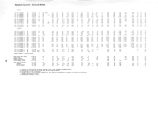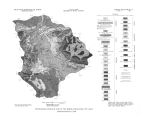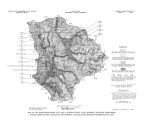| OCR Text |
Show Round Valley Creek and its south branch, Little Hobble Creek, drain Round Valley and the surrounding mountains. Round Valley Creek discharges to Deer Creek Reservoir. Fourteen small rock- basin lakes at the head of the main stem of the river and of North Fork have dams and outlet works, and function as storage reservoirs. The combined regulated capacity of these 14 small reservoirs is about 15,000 acre- feet. In addition, the discharge of the Lake Creek- Center Creek drainage is slightly regulated by several small reservoirs; the storage capacity of these small reservoirs is not reported. The only major impoundment on the Provo River system is Deer Creek Reservoir. Deer Creek Dam is located at the head of the lower Provo Canyon, and the high- water line of the reservoir forms the southern boundary of Heber Valley. The reservoir effectively controls the discharge of surface water from the Provo River drainage basin in the study area. Deer Creek Reservoir has a storage capacity of 152,560 acre- feet, and provides flood control as well as storage for irrigation and municipal use. Power is generated at the dam. Deer Creek Dam prevents the movement of ground water out of the study area through the unconsolidated alluvial fill in the river valley. The reservoir lies across a major fault zone, however, and it has been postulated that considerable quantities of water may be lost from the reservoir by subsurface movement along the Charleston and associated Deer Creek thrust faults. The water budget of the reservoir indicates no such loss. Water storage in Deer Creek Reservoir began in 1940. Nearly all the surface inflow and outflow of the reservoir was measured during the period October 1940- September 1949, so a fairly accurate water budget for the reservoir can be made for that period. The net difference between precipitation on the reservoir surface and adjacent slopes ( inflow) and evaporation from the reservoir ( outflow) is believed to be small and is neglected in the budget. The measured surface inflow to the reservoir averaged about 192,000 acre- feet per year. The total outflow through the Provo River ( the Salt Lake Aqueduct was not completed until 1950) averaged about 227,000 acre- feet per year, an increase of 35,000 acre- feet per year. In addition, about 110,000 acre- feet of water, an average of about 12,000 acre- feet per year, was stored in the reservoir; hence, the total gain ( excess of outflow and storage over inflow) was about 47,000 acre- feet per year. The extra 47,000 acre- feet of water per year presumably came from ground- water inflow from the alluvial fill in Heber Valley. There would appear to be no substantial loss of water from the reservoir through the subsurface. Water is added to the Provo River by diversions from the Weber River ( Weber- Provo Canal), the Duchesne River ( Duchesne Tunnel), and the Strawberry River system ( three small ditches that enter Daniels Creek). Water is diverted from the Provo River through the South Kamas and Washington Canal for irrigation in the south end of Rhodes Valley; some of the diverted water undoubtedly returns to the river as irrigation return flow. Water is also diverted from the basin through the Salt Lake Aqueduct, which carries water from Deer Creek Reservoir to the Jordan Valley for municipal use. Discharge The total discharge of the Provo River above Deer Creek Dam during the 14- year period 1953- 67 averaged 290,000 acre- feet per year. Of this amount, about 222,000 acre- feet originated within the drainage basin, and about 68,000 acre- feet was imported from other drainage basins. The U. S. Geological Survey has operated a gaging station on the Provo River at a point 1,000 feet downstream from Deer Creek Dam since May 1953. The average discharge of the river 8 |
































































































